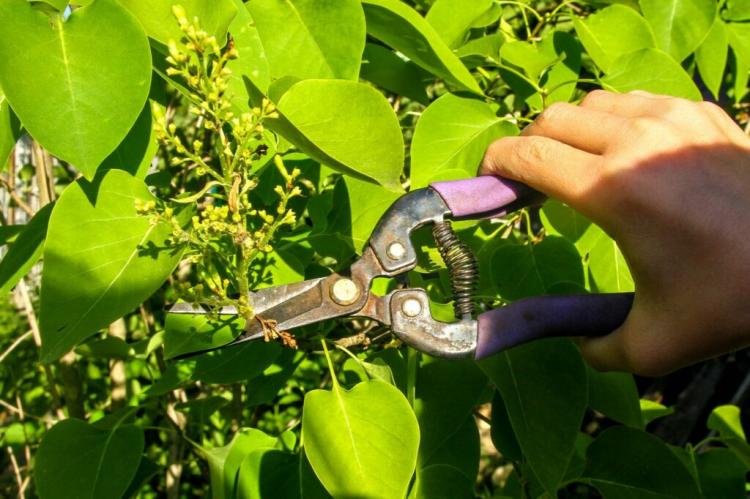Cutting Lilacs: When And How To Cut Back?
With its colorful blooms, the lilac is a striking feature in every garden. We show when and how it is best cut to keep it in shape.
The genus of lilacs ( Syringa ) includes several species. All of them stand out with their colorful and magnificent blooms in May or June in the home garden. But regardless of whether it is the famous common lilac ( Syringa vulgaris ) or a dwarf lilac (Syringa meyeri ‘Palibin’) – they should all be cut regularly so that they can adorn the garden in a beautiful shape for as long as possible.
When and how to cut lilacs?
Table of Contents
When it comes to the correct pruning of a tree or shrub, the same questions always arise:
- When is the right time?
- Which branches need to be cut?
- How far do I have to / may I cut back?

Of course, these questions also arise when cutting the lilac – and rightly so. Because the lilac can, depending on how radically cut back is to be, dance a little out of line. When cutting the lilac, you have to distinguish between different types of cut:
- Maintenance pruning (following the flowering of the lilac)
- Radical cut for rejuvenation (in autumn or spring)
- Parenting pruning for young lilacs (in autumn or spring)
In the following, we will take a closer look at the different shapes of the cut and show when which option is the best for the lilac.
Conservation pruning – pruning dwarf lilac
The so-called maintenance pruning is the optimal solution to keep a dwarf lilac in shape. But even with an ordinary lilac, which at 6 m in height can grow up to 4 m higher than a dwarf lilac, this form of pruning should be preferred to radical pruning. The following should be known about the conservation pruning in lilacs:
- Time: from mid / end of June when the flowers have faded
- Snap out the flowers as far down as possible.
- Occasionally cut back branches further to get a shape. Then you can cut back into the two / three-year-old wood.
- The further pruning of the branches rotates so that different branches are cut back from year to year.
Caution: do not cut back too far down into the new shoots. On these branches, there are already buds with flower systems for the next year. Therefore, at least three eyes should stop on the new shoot. If the cut is too deep, the lilac may not be able to bloom for the next year.

Thanks to the regular maintenance pruning following the flowering of the lilac, you keep it in shape and do not have to do without the beautiful, splendid bloom.
Radically cut and rejuvenate lilacs
If the beloved lilac has been neglected in recent years, it can lose its bushy shape over time. Weather-related breakage of branches can also disfigure the beloved lilac. A radical cut back then seems to be the last solution. There are two different options here, but they are not entirely without risk.
- Cut all the branches far back into the old wood at once
Of course, you can cut all the branches of the lilac all the way back into the old wood. This takes place in early spring before the new lilac shoots. However, there is then the risk that the lilac will no longer sprout from the old wood, but will merely form new root shoots.
First of all, after a radical cut back into the old wood, these must be removed in any case. By removing the root saplings, the energy is pushed into the old wood of the lilac. This preserves the possibility that any remaining dormant buds will sprout again.

- Divide the radical cut over several years
The radical cutback can also be spread over several years. Then the branches are shortened within two or three consecutive years. This is also done in early spring. On the one hand, the lilacs bloom at least partially despite radical pruning. On the other hand, the remaining, leafy branches ensure that the cell sap is pressed into the crown. The dormant eyes tend to sprout in the woody parts of the lilac and the sprouting of root shoots is not provoked as strongly as with radical pruning in one year.
You might so like: Purple Roses: The 5 Most Beautiful Varieties From Lilac To Purple
No matter whether all at once or over several years – it is important to always remove the unwanted root saplings. They steal the buds that should actually sprout after pruning, namely the energy. In addition, the newly emerging branches should be shortened again in the following years and only three to four strong secondary branches per the main branch should be left. This thinning after the radical cut is important in order to help the lilac to regain an attractive shape.

Raising young lilacs by cutting
You bought a young lilac at planting time in autumn or early spring – then it can certainly grow first, one might think. But that’s wrong because even a young lilac in your own garden needs full attention when it comes to cutting. The following must be observed when raising a lilac in the first few years:
- Cut out weak shoots
- Shorten main shoots (one third to one half)
- Repeat several times if necessary
- You may have to do without flowering at first, but the early pruning measures will pay off!

Cut dwarf lilac
Dwarf lilacs remain clearly inferior to common lilacs in terms of growth. That is why it is usually sufficient for these small specimens if regular maintenance pruning is carried out. This way the dwarf lilac stays in shape, branches well, and will always be in bloom.
You might so like:






